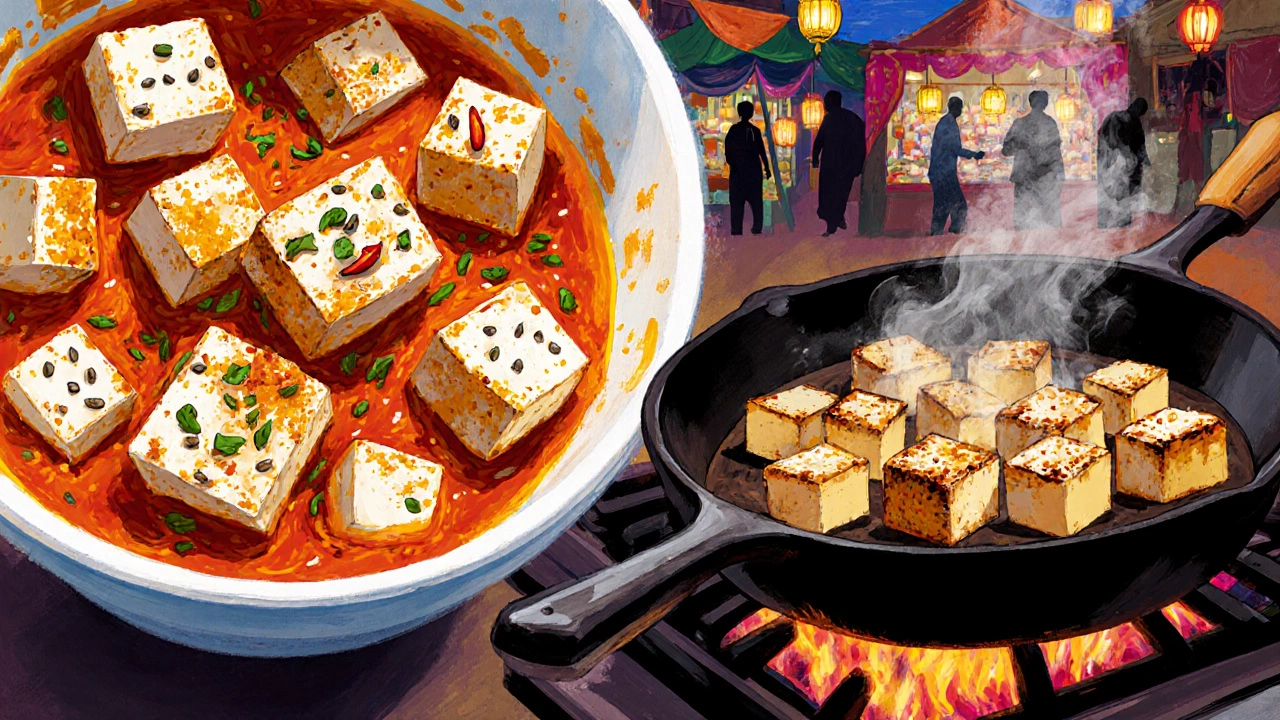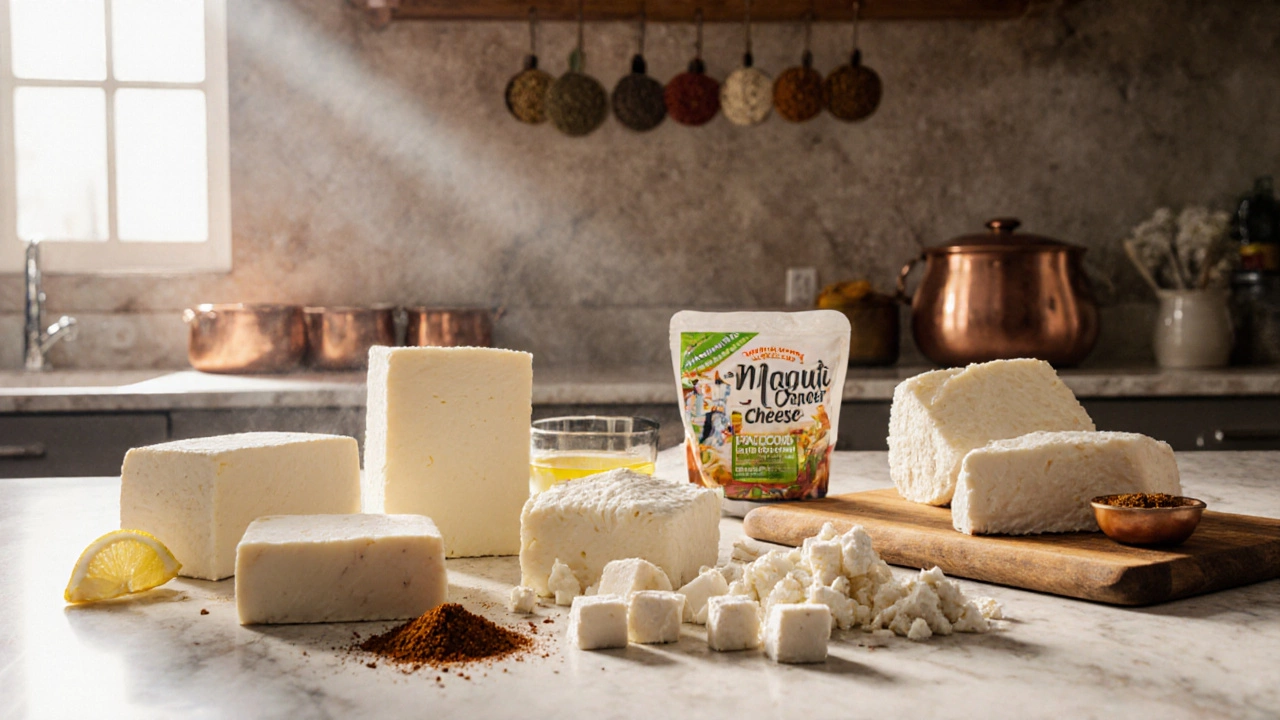Paneer Substitute Selector
Select your preferred cheese substitute below to learn about its suitability for paneer recipes:
Tofu
Firm or extra-firm, absorbs flavors well.
Halloumi
High melting point, great for grilling.
Ricotta
Creamy, works in mild gravies.
Mozzarella
Low-moisture, good for tomato-based dishes.
Queso Fresco
Crumbly, doesn't melt, ideal for salads.
Feta
Salty, tangy, works in spicy dishes.
Cottage Cheese
Soft, works in low-fat recipes.
Vegan Paneer
Plant-based, non-melting, ready-to-use.
When a recipe calls for paneer but you don’t have any on hand, the clock starts ticking. You could run to the nearest Indian grocery, but most of us need a quick kitchen fix. This guide shows you which cheeses work as paneer substitute and how to tweak your dishes so they still taste authentic.
What Is Paneer?
Paneer is a fresh, non‑melting Indian cheese made by curdling hot milk with lemon juice or vinegar. It has a mild, milky flavor and a firm, crumbly texture that holds up well in curries, grills, and salads. Because it doesn’t melt, paneer keeps its shape during high‑heat cooking, making it a staple in dishes likepalakpaneer,paneertikka, andmatarpaneer.
Key Factors for a Good Paneer Substitute
- Texture: Firm yet slightly spongy, able to retain its shape when sautéed or grilled.
- Flavor: Mild and milky, without strong herbs or tang.
- Moisture content: Low to moderate; excess moisture can water down sauces.
- Cookability: Should not melt into a gooey mess when exposed to high heat.
Top Cheese Alternatives
Below are the eight most reliable cheeses you can keep in the fridge for a quick paneer swap. Each entry includes a short definition wrapped in schema.org microdata for easy indexing.
1. Tofu (Firm or Extra‑Firm)
Tofu is a soy‑based curd with a barely perceptible flavor and a dense, sponge‑like texture. When pressed, it mimics paneer’s firmness and absorbs surrounding spices brilliantly. Cut into cubes, marinate, and grill just as you would paneer.
2. Halloumi
Halloumi is a semi‑hard cheese from Cyprus that squeaks when you bite it. It retains shape at high temperatures because it has a high melting point. Its salty bite works well in fried dishes, though you may want to rinse it to tone down the brine.
3. Ricotta (Drained)
Ricotta is an Italian whey cheese with a creamy, grainy texture. When well‑drained and pressed, it can form firm blocks that hold up in stews. Expect a softer bite, so use it in milder gravies where melting isn’t a concern.
4. Mozzarella (Low‑Moisture)
Mozzarella is an Italian cheese known for its stretchiness when melted. Low‑moisture versions have a firmer body and can be cubed and pan‑fried without disintegrating. The mild flavor makes it a decent stand‑in, especially in tomato‑based sauces.
5. Queso Fresco
Queso fresco is a crumbly Mexican cheese made from cow’s milk. It stays soft but doesn’t melt, offering a texture close to paneer’s. Its subtle tang works well in chutney‑based curries.
6. Feta Cheese
Feta is a brined Greek cheese with a crumbly, slightly grainy texture and a salty, tangy flavor. When crumbled into larger chunks, it can survive brief sautéing. Use it sparingly in dishes where a salty bite complements the sauce.
7. Cottage Cheese
Cottage cheese consists of curds pressed loosely together. Draining and patting it dry creates a texture that holds its shape in quick‑cook dishes. Ideal for low‑fat recipes, but it releases water, so press well.
8. Paneer‑Style Vegan Cheese (Soy or Almond Base)
Commercially available vegan “paneer” mimics the exact texture and neutral taste of traditional paneer. Look for brands that list soy, almond, or coconut oil as base ingredients and are labeled non‑melting.
How to Prep Each Substitute for Authentic Results
- Press out excess moisture. For tofu, wrap in a clean towel and place a weight for 15‑20 minutes. For cottage cheese, use a fine mesh strainer.
- Cube uniformly. Aim for 1‑inch pieces so cooking time mirrors that of paneer.
- Marinate with classic spices. A mix of turmeric, cumin, coriander, chili powder, and a splash of lemon juice reproduces the typical paneer flavor profile.
- Pre‑sear before adding to sauce. A quick sear on high heat creates a golden crust that mimics paneer’s charred edges.
- Adjust cooking time. Softer cheeses (ricotta, feta) need less time-add them in the last 5 minutes of simmering.

Texture & Flavor Comparison
| Cheese | Texture | Melting Point | Flavor Profile | Best Dish Pairings |
|---|---|---|---|---|
| Tofu | Firm, spongy | Does not melt | Neutral, absorbs spices | Curries, tikka, stir‑fries |
| Halloumi | Chewy, squeaky | High (non‑melting) | Salty, slightly tangy | Grilled skewers, fried bites |
| Ricotta | Creamy, grainy | Low‑to‑moderate | Milky, sweet | Saagricotta, mild gravies |
| Mozzarella | Semi‑firm, stretchy when heated | Low (melts) | Delicate dairy | Tomato‑based curries, baked dishes |
| Queso Fresco | \nSoft yet crumbly | Does not melt | Lightly salty | Fresh salads, quick sauté |
| Feta | Crumbly, moist | Low (softens) | Salty, tangy | Spicy stews, lentil dishes |
| Cottage Cheese | Soft curds | Low (may melt) | Mild, slightly sweet | Light sauces, health‑focused curries |
| Vegan Paneer | Firm, non‑melting | High | Neutral, plant‑based | All traditional paneer recipes |
Flavor‑Boosting Tips for Each Swap
- Tofu: Press and marinate for at least 30 minutes. A dash of nigella seeds adds an Indian twist.
- Halloumi: Slice thinly, coat lightly in chickpea flour, and fry to get a crisp crust without overwhelming salt.
- Ricotta: Mix with a pinch of turmeric and a squeeze of lemon after draining to mimic paneer’s subtle zest.
- Mozzarella: Pat dry, dust with gram flour, and shallow‑fry for a golden brown exterior.
- Queso Fresco: Rinse quickly to cut excess brine, then crumble over the dish just before serving.
- Feta: Crumble and sprinkle sparingly; its saltiness can replace the usual paneer seasoning.
- Cottage Cheese: Blend a small portion with water, strain, and press to form firmer blocks.
- Vegan Paneer: Follow package instructions; most varieties have a ready‑to‑cook texture that works straight from the pack.
Common Pitfalls and How to Avoid Them
Even the best substitutes can go wrong if you overlook a few details.
- Too much moisture. Water‑laden cheeses dilute sauces. Always press and pat dry.
- Over‑cooking. Soft cheeses melt or turn rubbery. Add them near the end of the cooking cycle.
- Unbalanced seasoning. Some substitutes (halloumi, feta) are salty. Reduce added salt accordingly.
- Missing the char. Paneer’s signature smoky edge comes from a quick sear. Replicate this by using a hot skillet and a light coating of oil.
Quick Takeaways
- Press and dry any cheese with high moisture before cooking.
- Match texture first, then flavor, to keep the dish authentic.
- For a true non‑melting experience, reach for tofu, halloumi, or vegan paneer.
- Adjust salt when using naturally salty cheeses like feta or halloumi.
- Finish with a brief high‑heat sear to recreate paneer’s signature crust.
Frequently Asked Questions
Can I use regular cheese like cheddar as a paneer substitute?
Cheddar melts quickly and has a sharp flavor, so it won’t hold its shape or taste like paneer. It works only in recipes where the cheese is already meant to melt, not in classic paneer curries.
Is tofu truly vegetarian for Indian dishes?
Yes. Firm tofu is plant‑based and fits vegetarian Indian cooking. It absorbs spices well, making it a go‑to paneer alternative for vegans and vegetarians alike.
How long should I marinate tofu before cooking?
At least 30 minutes, but a few hours yields deeper flavor. Use a mix of lemon juice, turmeric, cumin, and a pinch of salt for a classic paneer taste.
Will halloumi work in a spicy tikka masala?
Halloumi’s high melting point lets it stay firm in tikka masala. Rinse it first to tone down the brine, then marinate and grill just like paneer.
What’s the best way to remove excess water from cottage cheese?
Place cottage cheese in a fine‑mesh strainer, press gently with a spoon, and let it sit for 10‑15 minutes. For extra firmness, wrap the curds in cheesecloth and apply a light weight.
